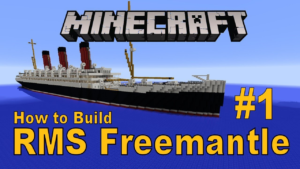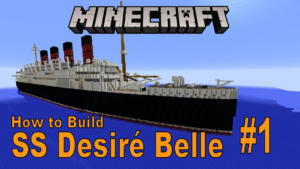Sub Categories
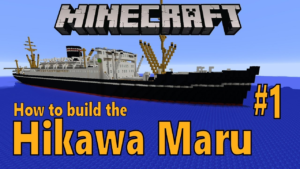
5 videos
Hikawa Maru (氷川丸) is a Japanese ocean liner that Yokohama Dock Company built for Nippon Yūsen Kabushiki Kaisha ("NYK Line"). She was launched on 30 September 1929 and made her maiden voyage from Kobe to Seattle on 13 May 1930. She is permanently berthed as a museum ship at Yamashita Park, Naka-ku, Yokohama.
Hikawa Maru was one of three Hikawa Maru class motor ships, all named after major Shinto shrines. The Hikawa Shrine is in Saitama in central Honshu. Her two sister ships, both lost in the Second World War, were Heian Maru and Hie Maru.
Hikawa Maru was one of three Hikawa Maru class motor ships, all named after major Shinto shrines. The Hikawa Shrine is in Saitama in central Honshu. Her two sister ships, both lost in the Second World War, were Heian Maru and Hie Maru.
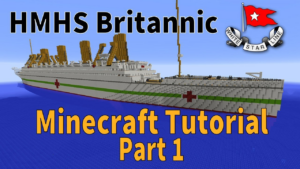
8 videos
HMHS Britannic (/brɪˈtænɪk/) was the third and final vessel of the White Star Line's Olympic class of steamships and the second to bear the name "Britannic." She was the fleet mate of both the RMS Olympic and the RMS Titanic and was intended to enter service as a transatlantic passenger liner.
Britannic was launched just before the start of the First World War. She was designed to be the safest of the three ships with design changes actioned during construction due to lessons learned from the sinking of the Titanic. She was laid up at her builders, Harland and Wolff, in Belfast for many months before being put to use as a hospital ship in 1915. In 1915 and 1916 she served between the United Kingdom and the Dardanelles. On the morning of 21 November 1916 she was shaken by an explosion caused by a naval mine of the Imperial German Navy near the Greek island of Kea and foundered 55 minutes later, killing 30 people.
There were 1,065 people on board; the 1,035 survivors were rescued from the water and lifeboats. Britannic was the largest ship lost in the First World War. The loss of the ship was compensated by the award of SS Bismarck to the White Star Line as part of postwar reparations; she became the RMS Majestic.
The wreck was located and explored by Jacques-Yves Cousteau in 1975. The vessel is the largest passenger ship on the sea floor
Britannic was launched just before the start of the First World War. She was designed to be the safest of the three ships with design changes actioned during construction due to lessons learned from the sinking of the Titanic. She was laid up at her builders, Harland and Wolff, in Belfast for many months before being put to use as a hospital ship in 1915. In 1915 and 1916 she served between the United Kingdom and the Dardanelles. On the morning of 21 November 1916 she was shaken by an explosion caused by a naval mine of the Imperial German Navy near the Greek island of Kea and foundered 55 minutes later, killing 30 people.
There were 1,065 people on board; the 1,035 survivors were rescued from the water and lifeboats. Britannic was the largest ship lost in the First World War. The loss of the ship was compensated by the award of SS Bismarck to the White Star Line as part of postwar reparations; she became the RMS Majestic.
The wreck was located and explored by Jacques-Yves Cousteau in 1975. The vessel is the largest passenger ship on the sea floor
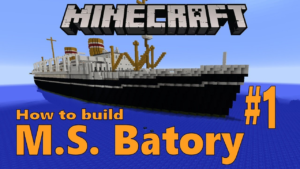
5 videos
M.S. Batory was an ocean liner of the Polish merchant fleet, named after Stefan Batory, the sixteenth-century king of Poland. She was the sister ship of the MS Piłsudski. Following wartime service for her country, mainly under the British Admiralty, she became in 1947 the pride of the Polish Ocean Lines and the Polish merchant fleet.

5 videos
This M.S. Deborah design is highly inspired but the MV Boudicca. A Royal Viking Star-class cruise ship that last served as accommodation vessel at Pendik, near Tuzla Shipyard. She was built in 1973 by Wärtsilä Helsinki Shipyard, Finland as Royal Viking Sky for Nordenfjeldske Dampskibsselskap, Trondheim, which placed the ship in Royal Viking Line service. In May 2021 the ship was beached in Aliağa for scrapping.
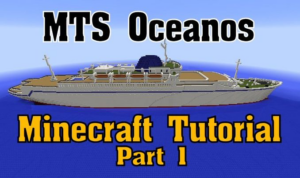
0 videos
The ship was launched in July 1952 by Forges et Chantiers de la Gironde in Bordeaux as the Jean Laborde, the last of four sister ships built for Messageries Maritimes. The ships were used on the Marseilles – Madagascar – Mauritius service. The Jean Laborde went through many different owners and name changes (Jean Laborde, Mykinai, Ancona, Eastern Princess) in the succeeding decades. In 1976, she was acquired by Epirotiki Lines of Greece and registered under the name of Oceanos.
Final voyage
On 3 August 1991, the Oceanos – initially delayed due to a bomb threat – set out from East London, South Africa and headed for Durban. Captain Yiannis Avranas (born ca. 1940) had been an officer for twenty years and a seaman for thirty. Oceanos headed into 40-knot winds and 9 m (30 ft) swells. Usually, there would have been a "sail-away" party on deck with the ship's musicians and British entertainers Moss and Tracy Hills. However, due to the rough seas, this was held inside in the Four Seasons lounge; most passengers chose to stay in their cabins.
The storm worsened as the evening progressed and when the first sitting of dinner was served, the waiters could hardly carry the trays of food without dropping something. Eventually the Oceanos was rolling about from side to side so badly that crockery and cutlery began sliding off the tables and potted plants fell over.
Flooding
While trying to make up time due to the earlier delay, the Oceanos encountered rough seas. Earlier repairs to the waste disposal system had not been completed, which meant that a vital ventilation pipe which ran through the watertight aft bulkhead and the non-return valves were not replaced. It's believed that after a series of freak waves slamming against the ship the pipe’s shell plating had burst open spilling seawater and began filling the compartment. At about 9:30 pm, a muffled explosion was heard and the Oceanos lost power. The ship started taking in water, rapidly flooding the engine room. By the next morning rescuers found the Oceanos adrift just off Coffee Bay, listing badly to its starboard side.
Rescue efforts
As no alarm or announcement had been given that the ship was in trouble, several passengers went to the bridge to look for the crew, only to find it unmanned. Moss Hills then used the radio phone to broadcast a Mayday distress call until a ship answered. Of the sixteen rescue helicopters that came out to the ship, thirteen were South African Defence Force (SADF) Pumas, nine of which hoisted 225 passengers off the deck. They were assisted by the lifeboats of the Dutch container ship Nedlloyd Mauritius, which had responded to the distress call.
All 571 people on board were saved. Hills organized the orderly evacuation of passengers by the helicopters and is generally acknowledged as the leading hero of the event. Hills and fellow entertainer Julian Butler directed the efforts of the entertainment staff, which included Hills' wife Tracy and Robin Boltman,[9] to assist the passengers. According to Boltman, "later in the morning, Captain Avarnasi (sic) even contacted me from shore to ask how things were going." Butler, Moss Hills and Tracy Hills were among the last five to be rescued.[not in citation given]
After many officers and crew abandoned ship, women and children were given priority when loading the lifeboats by cruise director Lorraine Betts. Later, after the ship's list became so severe that the remaining lifeboats were rendered useless, the remaining passengers had to be airlifted onto SADF helicopters by means of a safety harness. Betts again insisted that women and children be rescued first.
Final moments
The following day at approximately 15:30 UTC+2, the Oceanos rolled over onto her side and sank by the bow at 32.12093°S 29.12029°ECoordinates: 32.12093°S 29.12029°E. The last fifteen minutes of her sinking was captured on video and broadcast by ABC News
Final voyage
On 3 August 1991, the Oceanos – initially delayed due to a bomb threat – set out from East London, South Africa and headed for Durban. Captain Yiannis Avranas (born ca. 1940) had been an officer for twenty years and a seaman for thirty. Oceanos headed into 40-knot winds and 9 m (30 ft) swells. Usually, there would have been a "sail-away" party on deck with the ship's musicians and British entertainers Moss and Tracy Hills. However, due to the rough seas, this was held inside in the Four Seasons lounge; most passengers chose to stay in their cabins.
The storm worsened as the evening progressed and when the first sitting of dinner was served, the waiters could hardly carry the trays of food without dropping something. Eventually the Oceanos was rolling about from side to side so badly that crockery and cutlery began sliding off the tables and potted plants fell over.
Flooding
While trying to make up time due to the earlier delay, the Oceanos encountered rough seas. Earlier repairs to the waste disposal system had not been completed, which meant that a vital ventilation pipe which ran through the watertight aft bulkhead and the non-return valves were not replaced. It's believed that after a series of freak waves slamming against the ship the pipe’s shell plating had burst open spilling seawater and began filling the compartment. At about 9:30 pm, a muffled explosion was heard and the Oceanos lost power. The ship started taking in water, rapidly flooding the engine room. By the next morning rescuers found the Oceanos adrift just off Coffee Bay, listing badly to its starboard side.
Rescue efforts
As no alarm or announcement had been given that the ship was in trouble, several passengers went to the bridge to look for the crew, only to find it unmanned. Moss Hills then used the radio phone to broadcast a Mayday distress call until a ship answered. Of the sixteen rescue helicopters that came out to the ship, thirteen were South African Defence Force (SADF) Pumas, nine of which hoisted 225 passengers off the deck. They were assisted by the lifeboats of the Dutch container ship Nedlloyd Mauritius, which had responded to the distress call.
All 571 people on board were saved. Hills organized the orderly evacuation of passengers by the helicopters and is generally acknowledged as the leading hero of the event. Hills and fellow entertainer Julian Butler directed the efforts of the entertainment staff, which included Hills' wife Tracy and Robin Boltman,[9] to assist the passengers. According to Boltman, "later in the morning, Captain Avarnasi (sic) even contacted me from shore to ask how things were going." Butler, Moss Hills and Tracy Hills were among the last five to be rescued.[not in citation given]
After many officers and crew abandoned ship, women and children were given priority when loading the lifeboats by cruise director Lorraine Betts. Later, after the ship's list became so severe that the remaining lifeboats were rendered useless, the remaining passengers had to be airlifted onto SADF helicopters by means of a safety harness. Betts again insisted that women and children be rescued first.
Final moments
The following day at approximately 15:30 UTC+2, the Oceanos rolled over onto her side and sank by the bow at 32.12093°S 29.12029°ECoordinates: 32.12093°S 29.12029°E. The last fifteen minutes of her sinking was captured on video and broadcast by ABC News

5 videos
The MV Bloemfontein Castle was a passenger liner. She was launched at Harland & Wolff's yard at Belfast on 25 August 1949 by Mrs Leif Egeland, wife of the High Commissioner for the Union of South Africa in London. She was completed on 25 March 1950. Built for Union-Castle Line's Intermediate service to South and East Africa, she was their first one-class ship. She took her name after the town of Bloemfontein, capital of the Orange Free State.
The Bloemfontein Castle was given the familiar Union-Castle profile of well-raked rounded stem, cruiser stern, a low streamlined funnel and a single mast abaft the bridge, giving a well-balanced appearance. There were two hatches forward and three aft, served by six 10-ton and four 5-ton capacity derricks. Cargo 'tweendeck spaces were insulated for the carriage of fruit, with certain compartments for chilled and frozen produce.
The Bloemfontein Castle was the first intermediate liner to be built since the war had ended, and the institution of a single class-tourist was an innovation for Union-Castle. She was built to cater for an expected emigrant boom and to alleviate the still considerable pressure at the time for accommodation at lower range fares. The main public rooms were on the promenade deck, a large lounge forward being extended the whole width of the ship so there were no passageways either side. Aft of this was a combined library and writing room, connected by a long gallery to a commodious smoking room. On the upper deck a dining room for 386 also extended the width of the ship. Accommodation for 739 passengers was spread through seven decks.
Some 250 of Union-Castle's staff were invited for the shakedown cruise made from London in March, 1950. She left London on her maiden voyage on 6 April 1950 – sailing the London – Rotterdam – Las Palmas – Ascension – St. Helena – Walvis Bay – Cape Town – Port Elizabeth – East London – Durban – Lourenço Marques – Beira route that she alone served. She sometimes called at Southampton homewards during the busy fruit season.
On 8 January 1953, Bloemfontein Castle rescued 234 passengers and crew from the Holland Afrika liner Klipfontein which was sinking after hitting a sunken German U-boat off Mozambique. Captain J. A. Fergurson and his senior officers later received commemorative gifts from the Holland Afrika Line.
When the expected flow of European emigrants to South Africa did not materialize, Bloemfontein Castle was sold to the Greek Chandris Lines in 1959, after a short life of only nine years with Union-Castle.[1]
Renamed Patris and refitted in just three weeks for Chandris' service between Europe and Australia, the ship was the first large liner in the Chandris fleet. After Darwin was almost destroyed by Cyclone Tracy on Christmas Day in 1974, the Patris anchored in Darwin Harbour for nine months to provide emergency accommodation for those left homeless. In 1979 Chandris sold Patris to Karageorgis Lines, who first renamed her Mediterranean Island then Mediterranean Star in 1981. She was refitted and used as a ferry until sold to Pakistani breakers in 1987.
The Bloemfontein Castle was given the familiar Union-Castle profile of well-raked rounded stem, cruiser stern, a low streamlined funnel and a single mast abaft the bridge, giving a well-balanced appearance. There were two hatches forward and three aft, served by six 10-ton and four 5-ton capacity derricks. Cargo 'tweendeck spaces were insulated for the carriage of fruit, with certain compartments for chilled and frozen produce.
The Bloemfontein Castle was the first intermediate liner to be built since the war had ended, and the institution of a single class-tourist was an innovation for Union-Castle. She was built to cater for an expected emigrant boom and to alleviate the still considerable pressure at the time for accommodation at lower range fares. The main public rooms were on the promenade deck, a large lounge forward being extended the whole width of the ship so there were no passageways either side. Aft of this was a combined library and writing room, connected by a long gallery to a commodious smoking room. On the upper deck a dining room for 386 also extended the width of the ship. Accommodation for 739 passengers was spread through seven decks.
Some 250 of Union-Castle's staff were invited for the shakedown cruise made from London in March, 1950. She left London on her maiden voyage on 6 April 1950 – sailing the London – Rotterdam – Las Palmas – Ascension – St. Helena – Walvis Bay – Cape Town – Port Elizabeth – East London – Durban – Lourenço Marques – Beira route that she alone served. She sometimes called at Southampton homewards during the busy fruit season.
On 8 January 1953, Bloemfontein Castle rescued 234 passengers and crew from the Holland Afrika liner Klipfontein which was sinking after hitting a sunken German U-boat off Mozambique. Captain J. A. Fergurson and his senior officers later received commemorative gifts from the Holland Afrika Line.
When the expected flow of European emigrants to South Africa did not materialize, Bloemfontein Castle was sold to the Greek Chandris Lines in 1959, after a short life of only nine years with Union-Castle.[1]
Renamed Patris and refitted in just three weeks for Chandris' service between Europe and Australia, the ship was the first large liner in the Chandris fleet. After Darwin was almost destroyed by Cyclone Tracy on Christmas Day in 1974, the Patris anchored in Darwin Harbour for nine months to provide emergency accommodation for those left homeless. In 1979 Chandris sold Patris to Karageorgis Lines, who first renamed her Mediterranean Island then Mediterranean Star in 1981. She was refitted and used as a ferry until sold to Pakistani breakers in 1987.
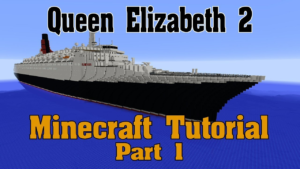
7 videos
Queen Elizabeth 2, often referred to simply as QE2, is a floating hotel and retired ocean liner originally built for the Cunard Line, which operated by Cunard as both a transatlantic liner and a cruise ship from 1969 to 2008. Since 18 April 2018, she has been operating as a floating hotel in Dubai.
QE2 was designed for the transatlantic service from her home port of Southampton, UK to New York, USA and was named after the earlier Cunard liner RMS Queen Elizabeth. She served as the flagship of the line from 1969 until succeeded by RMS Queen Mary 2 in 2004. QE2 was designed in Cunard's offices in Liverpool and Southampton and built in Clydebank, Scotland. She was considered the last of the transatlantic ocean liners until Queen Mary 2 entered service.
QE2 was also the last oil-fired passenger steamship to cross the Atlantic in scheduled liner service until she was refitted with a modern diesel powerplant in 1986–87. She undertook regular world cruises during almost 40 years of service, and later operated predominantly as a cruise ship, sailing out of Southampton, England. QE2 had no running mate and never ran a year-round weekly transatlantic express service to New York. She did, however, continue the Cunard tradition of regular scheduled transatlantic crossings every year of her service life. QE2 was never given a Royal Mail Ship designation, instead carrying the SS and later MV or MS prefixes in official documents.
QE2 was retired from active Cunard service on 27 November 2008. She had been acquired by the private equity arm of Dubai World, which planned to begin conversion of the vessel to a 500-room floating hotel moored at the Palm Jumeirah, Dubai. The 2008 financial crisis intervened, however, and the ship was laid up at Dubai Drydocks and later Port Rashid. Subsequent conversion plans were announced in 2012 and then again by the Oceanic Group in 2013, but both plans stalled. In November 2015, Cruise Arabia & Africa quoted DP World chairman Ahmed Sultan Bin Sulayem as saying that QE2 would not be scrapped and a Dubai-based construction company announced in March 2017 that it had been contracted to refurbish the ship. The restored QE2 opened to visitors on 18 April 2018, with a soft opening. The grand opening was set for October 2018.
QE2 was designed for the transatlantic service from her home port of Southampton, UK to New York, USA and was named after the earlier Cunard liner RMS Queen Elizabeth. She served as the flagship of the line from 1969 until succeeded by RMS Queen Mary 2 in 2004. QE2 was designed in Cunard's offices in Liverpool and Southampton and built in Clydebank, Scotland. She was considered the last of the transatlantic ocean liners until Queen Mary 2 entered service.
QE2 was also the last oil-fired passenger steamship to cross the Atlantic in scheduled liner service until she was refitted with a modern diesel powerplant in 1986–87. She undertook regular world cruises during almost 40 years of service, and later operated predominantly as a cruise ship, sailing out of Southampton, England. QE2 had no running mate and never ran a year-round weekly transatlantic express service to New York. She did, however, continue the Cunard tradition of regular scheduled transatlantic crossings every year of her service life. QE2 was never given a Royal Mail Ship designation, instead carrying the SS and later MV or MS prefixes in official documents.
QE2 was retired from active Cunard service on 27 November 2008. She had been acquired by the private equity arm of Dubai World, which planned to begin conversion of the vessel to a 500-room floating hotel moored at the Palm Jumeirah, Dubai. The 2008 financial crisis intervened, however, and the ship was laid up at Dubai Drydocks and later Port Rashid. Subsequent conversion plans were announced in 2012 and then again by the Oceanic Group in 2013, but both plans stalled. In November 2015, Cruise Arabia & Africa quoted DP World chairman Ahmed Sultan Bin Sulayem as saying that QE2 would not be scrapped and a Dubai-based construction company announced in March 2017 that it had been contracted to refurbish the ship. The restored QE2 opened to visitors on 18 April 2018, with a soft opening. The grand opening was set for October 2018.
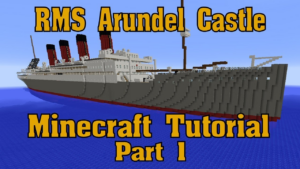
7 videos
RMS Arundel Castle was a British ocean liner and Royal Mail Ship which entered service in 1921 for the Union-Castle Line. A previous vessel of the same name was built in 1864 by Donald Currie & Co. (a predecessor to Union-Castle) and sold in 1883, whereupon it was renamed Chittagong. Originally laid down as the Amroth Castle in 1915, building was delayed by the First World War. She was eventually launched on 11 September 1919.
Her sister ship was RMS Windsor Castle and they were the only four-funneled liners not built for transatlantic service. She received a refit in 1937, with her four funnels being reconfigured into two, with new Babcock-Johnson boilers,[3] her hull lengthened, and her bow remodelled from a blunt chisel-style into a more modern, angular design. She served in the Second World War as a transport in the Mediterranean.
Arundel Castle made her 211th and final voyage in 1958, leaving Cape Town on 5 December and arriving in Southampton on 19 December. On 30 December she left for Kowloon on her way to Chiap Hua, the ship breakers in Hong Kong. When the ship arrived in Hong Kong harbour, Chiap Hua organised a lavish cocktail party on board the vessel with many of Hong Kong's dignitaries including government officials and bank executives. The ship’s furnishings and accessories—including the chronometers, captain’s armchair, steering wheel, crockery and sterling silver cutlery—were offered as gifts.
In her career she had steamed 2,850,000 miles in peace-time service and 625,565 as a troopship.
Colour film of Arundel Castle in Hong Kong can be seen in the Look At Life film, "Ticket to Tokyo," released in April 1959.
Her sister ship was RMS Windsor Castle and they were the only four-funneled liners not built for transatlantic service. She received a refit in 1937, with her four funnels being reconfigured into two, with new Babcock-Johnson boilers,[3] her hull lengthened, and her bow remodelled from a blunt chisel-style into a more modern, angular design. She served in the Second World War as a transport in the Mediterranean.
Arundel Castle made her 211th and final voyage in 1958, leaving Cape Town on 5 December and arriving in Southampton on 19 December. On 30 December she left for Kowloon on her way to Chiap Hua, the ship breakers in Hong Kong. When the ship arrived in Hong Kong harbour, Chiap Hua organised a lavish cocktail party on board the vessel with many of Hong Kong's dignitaries including government officials and bank executives. The ship’s furnishings and accessories—including the chronometers, captain’s armchair, steering wheel, crockery and sterling silver cutlery—were offered as gifts.
In her career she had steamed 2,850,000 miles in peace-time service and 625,565 as a troopship.
Colour film of Arundel Castle in Hong Kong can be seen in the Look At Life film, "Ticket to Tokyo," released in April 1959.
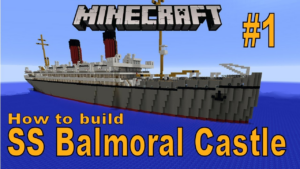
3 videos
The RMS Balmoral Castle (II) was a passenger steamer put into service in 1910, which was used by the British shipping company Union-Castle Line in passenger and mail traffic between Great Britain and South Africa . For years she was one of the largest ships in the shipping company. In 1939 she was scrapped in Wales.
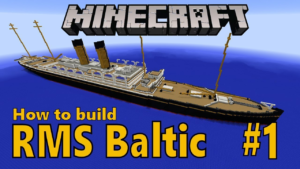
6 videos
RMS Baltic was an ocean liner of the White Star Line that sailed between 1904 and 1933. At 23,876 gross tons, she was the world's largest ship until 1905. She was the third of a quartet of ships, all measuring over 20,000 gross tons, dubbed The Big Four (the other three being RMS Celtic, Cedric, and Adriatic).
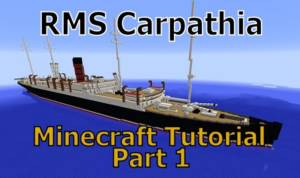
8 videos
RMS Carpathia was a Cunard Line transatlantic passenger steamship built by Swan Hunter & Wigham Richardson in their shipyard in Newcastle upon Tyne, England.
Carpathia made her maiden voyage in 1903 from Liverpool to Boston (Massachusetts), and continued on this route before being transferred to Mediterranean service in 1904. In April 1912, she became famous for rescuing the survivors of rival White Star Line's RMS Titanic after the latter struck an iceberg and sank with a loss of 1,517 lives in the North Atlantic Ocean. Carpathia braved dangerous ice fields and diverted all steam power to her engines in her rescue mission. She arrived only two hours after Titanic had sunk and rescued 705 survivors from the ship's lifeboats.
Carpathia herself was sunk on 17 July 1918 after being torpedoed by the German submarine SM U-55 off the southern Irish coast with a loss of five crew members.
The name of the ship comes from the mountain range of the Carpathians.
Carpathia made her maiden voyage in 1903 from Liverpool to Boston (Massachusetts), and continued on this route before being transferred to Mediterranean service in 1904. In April 1912, she became famous for rescuing the survivors of rival White Star Line's RMS Titanic after the latter struck an iceberg and sank with a loss of 1,517 lives in the North Atlantic Ocean. Carpathia braved dangerous ice fields and diverted all steam power to her engines in her rescue mission. She arrived only two hours after Titanic had sunk and rescued 705 survivors from the ship's lifeboats.
Carpathia herself was sunk on 17 July 1918 after being torpedoed by the German submarine SM U-55 off the southern Irish coast with a loss of five crew members.
The name of the ship comes from the mountain range of the Carpathians.
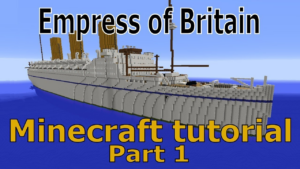
9 videos
The RMS Empress of Britain was an ocean liner built between 1928 and 1931 by John Brown shipyard in Scotland and owned by Canadian Pacific Steamship Company. This ship was the second of three CP vessels named Empress of Britain — provided scheduled trans-Atlantic passenger service from spring to autumn between Canada and Europe from 1931 until 1939.
In her time, Empress of Britain was the largest, fastest, and most luxurious ship between England and Canada. She was torpedoed on 28 October 1940 by U-32 and sank. At 42,348 gross tons, she was the largest liner lost during the Second World War and the largest ship sunk by a U-boat
In her time, Empress of Britain was the largest, fastest, and most luxurious ship between England and Canada. She was torpedoed on 28 October 1940 by U-32 and sank. At 42,348 gross tons, she was the largest liner lost during the Second World War and the largest ship sunk by a U-boat
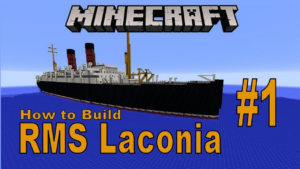
4 videos
RMS Laconia was a Cunard ocean liner built by Swan Hunter & Wigham Richardson, launched on 27 July 1911, with the wife of the U.S. Ambassador Mrs. Whitelaw Reid christening the vessel. Laconia was delivered to the Cunard Line on 12 December 1911, and began service on 20 January 1912. She was the first Cunard ship of that name. She was torpedoed and sunk on 25 February 1917 during World War 1, 12 passengers were killed.
Laconia was intended for the Liverpool-Boston service with cruising from New York to the Mediterranean off season. The ship was the first British ship and first North Atlantic liner to be equipped with anti-roll tanks.
Laconia was intended for the Liverpool-Boston service with cruising from New York to the Mediterranean off season. The ship was the first British ship and first North Atlantic liner to be equipped with anti-roll tanks.

8 videos
RMS Lusitania was a British ocean liner that was sunk on 7 May 1915 by a German U-boat 11 miles (18 km) off the southern coast of Ireland. The sinking presaged the United States declaration of war on Germany two years later.
Lusitania held the Blue Riband appellation for the fastest Atlantic crossing and was briefly the world's largest passenger ship until the completion of her sister ship Mauretania three months later. The Cunard Line launched her in 1906 at a time of fierce competition for the North Atlantic trade. She was sunk on her 202nd trans-Atlantic crossing.
German shipping lines were aggressive competitors for the custom of transatlantic passengers in the early 20th century, and Cunard responded by trying to outdo them in speed, capacity, and luxury. Cunard used assistance from the British Admiralty to build Lusitania, on the understanding that the ship would be available as a light merchant cruiser in time of war. She had gun mounts for deck cannons, but no guns were ever installed.
Both Lusitania and Mauretania were fitted with revolutionary new turbine engines that enabled them to maintain a service speed of 25 knots (46 km/h; 29 mph). They were equipped with lifts, wireless telegraph, and electric light, and provided 50-percent more passenger space than any other ship; the first-class decks were noted for their sumptuous furnishings.
The Royal Navy had blockaded Germany at the start of the First World War; the UK declared the entire North Sea a war zone in the autumn of 1914 and mined the approaches. In the spring of 1915, all food imports for Germany were declared contraband. RMS Lusitania left New York for Britain on 1 May 1915 when German submarine warfare was intensifying in the Atlantic. Germany had declared the seas around the United Kingdom a war zone, and the German embassy in the United States had placed newspaper advertisements warning people of the dangers of sailing on Lusitania.
On the afternoon of 7 May, a German U-boat torpedoed Lusitania 11 miles (18 km) off the southern coast of Ireland inside the declared war zone. A second internal explosion sank her in 18 minutes, killing 1,198 passengers and crew.
The Germans justified treating Lusitania as a naval vessel because she was carrying hundreds of tons of war munitions, making her a legitimate military target, and they argued that British merchant ships had violated the cruiser rules from the very beginning of the war. The internationally recognized cruiser rules were obsolete by 1915; it had become more dangerous for submarines to surface and give warning with the British introduction of Q-ships in 1915 with concealed deck guns. The Germans argued that Lusitania was regularly transporting war munitions; she operated under the control of the Admiralty; she could be converted into an armed auxiliary cruiser to join the war; her identity had been disguised; and she flew no flags. They claimed that she was a non-neutral vessel in a declared war zone, with orders to evade capture and ram challenging submarines.
However, the ship was not armed for battle and was carrying thousands of civilian passengers, and the British government accused the Germans of breaching the cruiser rules (even if they were not). The sinking caused a storm of protest in the United States because 128 American citizens were among the dead. The sinking shifted public opinion in the United States against Germany and was one of the factors in the declaration of war nearly two years later. After the First World War, successive British governments maintained that there were no munitions on board Lusitania, and the Germans were not justified in treating the ship as a naval vessel. In 1982, the head of the British Foreign Office's American department finally admitted that there is a large amount of ammunition in the wreck, some of which is highly dangerous and poses a safety risk to salvage teams
Lusitania held the Blue Riband appellation for the fastest Atlantic crossing and was briefly the world's largest passenger ship until the completion of her sister ship Mauretania three months later. The Cunard Line launched her in 1906 at a time of fierce competition for the North Atlantic trade. She was sunk on her 202nd trans-Atlantic crossing.
German shipping lines were aggressive competitors for the custom of transatlantic passengers in the early 20th century, and Cunard responded by trying to outdo them in speed, capacity, and luxury. Cunard used assistance from the British Admiralty to build Lusitania, on the understanding that the ship would be available as a light merchant cruiser in time of war. She had gun mounts for deck cannons, but no guns were ever installed.
Both Lusitania and Mauretania were fitted with revolutionary new turbine engines that enabled them to maintain a service speed of 25 knots (46 km/h; 29 mph). They were equipped with lifts, wireless telegraph, and electric light, and provided 50-percent more passenger space than any other ship; the first-class decks were noted for their sumptuous furnishings.
The Royal Navy had blockaded Germany at the start of the First World War; the UK declared the entire North Sea a war zone in the autumn of 1914 and mined the approaches. In the spring of 1915, all food imports for Germany were declared contraband. RMS Lusitania left New York for Britain on 1 May 1915 when German submarine warfare was intensifying in the Atlantic. Germany had declared the seas around the United Kingdom a war zone, and the German embassy in the United States had placed newspaper advertisements warning people of the dangers of sailing on Lusitania.
On the afternoon of 7 May, a German U-boat torpedoed Lusitania 11 miles (18 km) off the southern coast of Ireland inside the declared war zone. A second internal explosion sank her in 18 minutes, killing 1,198 passengers and crew.
The Germans justified treating Lusitania as a naval vessel because she was carrying hundreds of tons of war munitions, making her a legitimate military target, and they argued that British merchant ships had violated the cruiser rules from the very beginning of the war. The internationally recognized cruiser rules were obsolete by 1915; it had become more dangerous for submarines to surface and give warning with the British introduction of Q-ships in 1915 with concealed deck guns. The Germans argued that Lusitania was regularly transporting war munitions; she operated under the control of the Admiralty; she could be converted into an armed auxiliary cruiser to join the war; her identity had been disguised; and she flew no flags. They claimed that she was a non-neutral vessel in a declared war zone, with orders to evade capture and ram challenging submarines.
However, the ship was not armed for battle and was carrying thousands of civilian passengers, and the British government accused the Germans of breaching the cruiser rules (even if they were not). The sinking caused a storm of protest in the United States because 128 American citizens were among the dead. The sinking shifted public opinion in the United States against Germany and was one of the factors in the declaration of war nearly two years later. After the First World War, successive British governments maintained that there were no munitions on board Lusitania, and the Germans were not justified in treating the ship as a naval vessel. In 1982, the head of the British Foreign Office's American department finally admitted that there is a large amount of ammunition in the wreck, some of which is highly dangerous and poses a safety risk to salvage teams
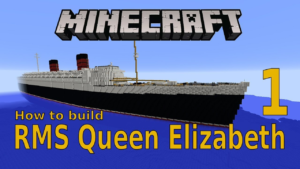
8 videos
RMS Queen Elizabeth

The RMS Queen Elizabeth was an ocean liner operated by Cunard Line. Alongside Queen Mary, they provided weekly luxury liner service between Southampton, UK and New York City, USA. Services went via Cherbourg in France.
Construction
John Brown and Company built Queen Elizabeth at Clydebank in Scotland. During construction, she was known as Hull 552 in the mid-1930s. Launched on 27 September 1938, she was named in honour of Queen Elizabeth, then Queen Consort to King George VI, who became the Queen Mother in 1952. With a design that improved upon that of Queen Mary, Queen Elizabeth was a slightly larger ship which made it the largest passenger liner ever built at the time and for a further 56 years thereafter.
Queen Elizabeth first entered service in February 1940 as a troopship in the Second World War but it was not until October 1946 that she served in her intended role as an ocean liner.
End of service
Queen Elizabeth 2 replaced both ships in 1969 due to the decline in popularity of the transatlantic route. Queen Mary retired from service on 9 December 1967, and was sold to the city of Long Beach, California. Queen Elizabeth was sold to a succession of buyers, most of whom had unsuccessful plans for her. Hong Kong businessman, Tung Chao Yung bought the ship intending to convert her into a floating university cruise ship. The intention was to rename the cruise ship, Seawise University. In 1972, whilst she was undergoing refurbishment in Hong Kong harbour, fire broke out aboard under unexplained circumstances. The ship capsized by the water used to fight the fire.
Her wreck was deemed an obstruction to shipping in the following year and during 1974 and 1975 was partially scrapped where she lay.
(Source: Wikipedia)
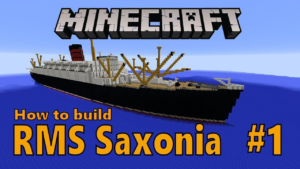
5 videos
RMS Saxonia was a British passenger liner built by John Brown & Company at Clydebank, Scotland. She was built for the Cunard Steamship Company for their Liverpool-Montreal service. Saxonia was the first of four almost identical sister ships built by Browns between 1954 and 1957 for UK-Montreal service. The first two of these ships, Saxonia and Ivernia were rebuilt in 1962/3 as dual purpose liner/cruise ships. They were renamed Carmania and Franconia respectively and painted in the same green cruising livery as the Caronia.
Carmania continued transatlantic crossings and cruises until September 1967. This is when she closed out Cunard's Montreal service. At the end of 1966, both ships were painted white. From 1968, Carmania sailed as a full time cruise ship until withdrawal after arriving at Southampton on 31 October 1971. The Soviet Union-based Black Sea Shipping Company bought Carmania in August 1973. Carmania's name changed once again, this time to SS Leonid Sobinov. The ship was scrapped in 1999.
Carmania continued transatlantic crossings and cruises until September 1967. This is when she closed out Cunard's Montreal service. At the end of 1966, both ships were painted white. From 1968, Carmania sailed as a full time cruise ship until withdrawal after arriving at Southampton on 31 October 1971. The Soviet Union-based Black Sea Shipping Company bought Carmania in August 1973. Carmania's name changed once again, this time to SS Leonid Sobinov. The ship was scrapped in 1999.
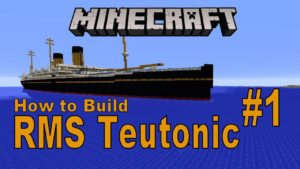
3 videos
The RMS Teutonic was an ocean liner built for the White Star Line in Belfast and was the first armed merchant cruiser.
During the first 18 years of service, both Teutonic and Majestic, along with their older cousins Britannic and Germanic sailed on the route from their home port of Liverpool to New York City. Each ship made on average one sailing per month, and averaged 11–14 sailings each season. The White Star Line had it planned so as they could operate a weekly service across the North Atlantic. Each week a ship sailed from Liverpool on a specific day, commonly Wednesday or Thursday. From there, they would stop at the port of Queenstown (now Cobh), Ireland, to pick up more passengers. Records have shown that Teutonic and her partner ships picked up as many as 800 Irish immigrants in a single stop, as the White Star Line was very popular in Ireland because most of their ships, including Teutonic, were Irish built.[citation needed]
After Queenstown, the ships would then continue on the long voyage to New York, almost 2,500 miles of open sea. Once passengers were disbursed at either the White Star Line pier in New York or the immigration centre at Castle Garden, and later on Ellis Island, the ship would be prepared for her return voyage.
Transatlantic races between the Teutonic and liner City of New York were common in the 19th-century. They usually began in either Queenstown Harbour or New York Harbor. On August 14, 1890, the Teutonic beat the City of New York by over three hours, and broke the ocean record by coming from Queenstown in 5 days, 19 hours, and 5 minutes, and breaking the record by 13 minutes.
In 1897 Teutonic reassumed her military role for a review commemorating Victoria's 60th anniversary. In 1898, she had a minor collision in New York Harbor with the United States Lines' Berlin, but neither ship suffered major damage.
During the Boer War in 1900, she served as a troop transport. In 1901, Teutonic encountered a tsunami, which washed two lookouts out of the crows nest who survived. The tsunami hit at night, so there were no passengers up on deck.
In 1907 Teutonic, along with Majestic, Oceanic and the new Adriatic was transferred to White Star's new 'Express Service' between Southampton and New York via Cherbourg and Queenstown. In 1911, the ship was replaced in the White Star lineup by the new Olympic and transferred to sister company Dominion Line for Canadian service. At the end of her career on White Star's UK-US services, she had carried a total of 209,466 passengers westbound[4] and another 125,720 eastbound. By 1913 Teutonic's age meant that she no longer attracted the top class passengers, and so was refitted to carry only second and third class passengers. In October 1913 the ship narrowly avoided the same fate as Titanic when, at 172 miles east of Belle Isle off the Newfoundland coast, she ran so close to an iceberg that she avoided collision only by reversing her engines and putting the helm hard aport. According to the 29 October 1913 issue of the Chicago Tribune, "the liner passed within twenty feet of the iceberg. The fog was so thick that even at that small distance the berg could scarcely be distinguished. It was so close that there was danger that the propeller of the ship would strike it as the vessel went around. The passengers were not aware of their peril until it had been averted. They signed a testimonial to the captain and his officers expressing their gratitude and admiration for the care and skill displayed by them."
In 1914, with the start of World War I, Teutonic became a merchant cruiser once again, being commissioned into the 10th Cruiser Squadron. In 1916, she was refitted with 6" guns, and served as a convoy escort ship as well as being used for troop transport.
In 1921, Teutonic was scrapped at Emden.
During the first 18 years of service, both Teutonic and Majestic, along with their older cousins Britannic and Germanic sailed on the route from their home port of Liverpool to New York City. Each ship made on average one sailing per month, and averaged 11–14 sailings each season. The White Star Line had it planned so as they could operate a weekly service across the North Atlantic. Each week a ship sailed from Liverpool on a specific day, commonly Wednesday or Thursday. From there, they would stop at the port of Queenstown (now Cobh), Ireland, to pick up more passengers. Records have shown that Teutonic and her partner ships picked up as many as 800 Irish immigrants in a single stop, as the White Star Line was very popular in Ireland because most of their ships, including Teutonic, were Irish built.[citation needed]
After Queenstown, the ships would then continue on the long voyage to New York, almost 2,500 miles of open sea. Once passengers were disbursed at either the White Star Line pier in New York or the immigration centre at Castle Garden, and later on Ellis Island, the ship would be prepared for her return voyage.
Transatlantic races between the Teutonic and liner City of New York were common in the 19th-century. They usually began in either Queenstown Harbour or New York Harbor. On August 14, 1890, the Teutonic beat the City of New York by over three hours, and broke the ocean record by coming from Queenstown in 5 days, 19 hours, and 5 minutes, and breaking the record by 13 minutes.
In 1897 Teutonic reassumed her military role for a review commemorating Victoria's 60th anniversary. In 1898, she had a minor collision in New York Harbor with the United States Lines' Berlin, but neither ship suffered major damage.
During the Boer War in 1900, she served as a troop transport. In 1901, Teutonic encountered a tsunami, which washed two lookouts out of the crows nest who survived. The tsunami hit at night, so there were no passengers up on deck.
In 1907 Teutonic, along with Majestic, Oceanic and the new Adriatic was transferred to White Star's new 'Express Service' between Southampton and New York via Cherbourg and Queenstown. In 1911, the ship was replaced in the White Star lineup by the new Olympic and transferred to sister company Dominion Line for Canadian service. At the end of her career on White Star's UK-US services, she had carried a total of 209,466 passengers westbound[4] and another 125,720 eastbound. By 1913 Teutonic's age meant that she no longer attracted the top class passengers, and so was refitted to carry only second and third class passengers. In October 1913 the ship narrowly avoided the same fate as Titanic when, at 172 miles east of Belle Isle off the Newfoundland coast, she ran so close to an iceberg that she avoided collision only by reversing her engines and putting the helm hard aport. According to the 29 October 1913 issue of the Chicago Tribune, "the liner passed within twenty feet of the iceberg. The fog was so thick that even at that small distance the berg could scarcely be distinguished. It was so close that there was danger that the propeller of the ship would strike it as the vessel went around. The passengers were not aware of their peril until it had been averted. They signed a testimonial to the captain and his officers expressing their gratitude and admiration for the care and skill displayed by them."
In 1914, with the start of World War I, Teutonic became a merchant cruiser once again, being commissioned into the 10th Cruiser Squadron. In 1916, she was refitted with 6" guns, and served as a convoy escort ship as well as being used for troop transport.
In 1921, Teutonic was scrapped at Emden.
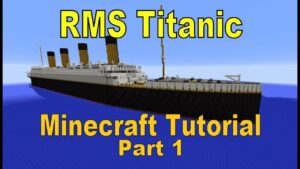
11 videos
RMS Titanic was a British passenger liner that sank in the North Atlantic Ocean in the early morning hours of 15 April 1912. It collided with an iceberg during its maiden voyage from Southampton to New York City. There were an estimated 2,224 passengers and crew aboard the ship, and more than 1,500 died. This made it one of the deadliest commercial peacetime maritime disasters in modern history.
The RMS Titanic was the largest ship afloat at the time it entered service. It was the second of three Olympic-class ocean liners operated by the White Star Line. The Titanic was built by the Harland and Wolff shipyard in Belfast. Thomas Andrews, her architect, died in the disaster. Titanic was under the command of Edward Smith, who also went down with the ship. The ocean liner carried some of the wealthiest people in the world, as well as hundreds of emigrants. Emigrants came from Great Britain and Ireland and elsewhere throughout Europe and Scandinavia who were seeking a new life in the United States.
The first-class accommodation was designed to be the pinnacle of comfort and luxury. It had an on-board gymnasium, swimming pool, libraries, high-class restaurants and opulent cabins. A high-powered radiotelegraph transmitter was available for sending passenger "marconigrams" and for the ship's operational use.
Although Titanic had advanced safety features such as watertight compartments and remotely activated watertight doors, there were not enough lifeboats to accommodate all those aboard, due to outdated maritime safety regulations. Titanic only carried enough lifeboats for 1,178 people—slightly more than half of the number on board, and one third of her total capacity. The ship carried a total of 16 lifeboat davits which could lower three lifeboats each, for a total of 48 boats. However, Titanic carried only a total of 20 lifeboats, four of which were collapsible and proved to be hard to launch during the sinking. After leaving Southampton on 10 April 1912, Titanic called at Cherbourg in France and Queenstown (now Cobh) in Ireland before heading west to New York.
On 14 April, four days into the crossing and about 375 miles (600 km) south of Newfoundland, she hit an iceberg at 11:40 p.m. ship's time. The collision caused the ship's hull plates to buckle inwards along her starboard (right) side and opened five of her sixteen watertight compartments to the sea; she could only survive four flooding. Meanwhile, passengers and some crew members were evacuated in lifeboats, many of which were launched only partially loaded.
A disproportionate number of men were left aboard because of a "women and children first" protocol for loading lifeboats. At 2:20 a.m., she broke apart and foundered—with well over one thousand people still aboard. Under two hours after the Titanic sank, the Cunard liner RMS Carpathia arrived at the scene, where she brought aboard an estimated 705 survivors.
The RMS Titanic was the largest ship afloat at the time it entered service. It was the second of three Olympic-class ocean liners operated by the White Star Line. The Titanic was built by the Harland and Wolff shipyard in Belfast. Thomas Andrews, her architect, died in the disaster. Titanic was under the command of Edward Smith, who also went down with the ship. The ocean liner carried some of the wealthiest people in the world, as well as hundreds of emigrants. Emigrants came from Great Britain and Ireland and elsewhere throughout Europe and Scandinavia who were seeking a new life in the United States.
The first-class accommodation was designed to be the pinnacle of comfort and luxury. It had an on-board gymnasium, swimming pool, libraries, high-class restaurants and opulent cabins. A high-powered radiotelegraph transmitter was available for sending passenger "marconigrams" and for the ship's operational use.
Although Titanic had advanced safety features such as watertight compartments and remotely activated watertight doors, there were not enough lifeboats to accommodate all those aboard, due to outdated maritime safety regulations. Titanic only carried enough lifeboats for 1,178 people—slightly more than half of the number on board, and one third of her total capacity. The ship carried a total of 16 lifeboat davits which could lower three lifeboats each, for a total of 48 boats. However, Titanic carried only a total of 20 lifeboats, four of which were collapsible and proved to be hard to launch during the sinking. After leaving Southampton on 10 April 1912, Titanic called at Cherbourg in France and Queenstown (now Cobh) in Ireland before heading west to New York.
On 14 April, four days into the crossing and about 375 miles (600 km) south of Newfoundland, she hit an iceberg at 11:40 p.m. ship's time. The collision caused the ship's hull plates to buckle inwards along her starboard (right) side and opened five of her sixteen watertight compartments to the sea; she could only survive four flooding. Meanwhile, passengers and some crew members were evacuated in lifeboats, many of which were launched only partially loaded.
A disproportionate number of men were left aboard because of a "women and children first" protocol for loading lifeboats. At 2:20 a.m., she broke apart and foundered—with well over one thousand people still aboard. Under two hours after the Titanic sank, the Cunard liner RMS Carpathia arrived at the scene, where she brought aboard an estimated 705 survivors.
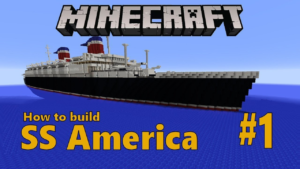
7 videos
SS America was an ocean liner built in 1940 for the United States Lines and was designed by the noted American naval architect William Francis Gibbs. She carried many names in the 54 years between her construction and her 1994 wreck: SS America (carrying this name three different times during her career); troop transport USS West Point; and SS Australis, Italis, Noga, Alferdoss, and American Star. She served most notably in passenger service as America and the Greek-flagged Australis.
She was wrecked as the American Star at Playa de Garcey on Fuerteventura in the Canary Islands on 18 January 1994. The wreck has broken up and collapsed into the sea. Only a small section of the bow remains visible during low tide
She was wrecked as the American Star at Playa de Garcey on Fuerteventura in the Canary Islands on 18 January 1994. The wreck has broken up and collapsed into the sea. Only a small section of the bow remains visible during low tide
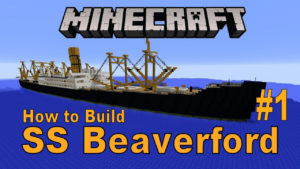
4 videos
SS Beaverford was a cargo liner registered in the United Kingdom and operated by the Canadian Pacific Steamship Company. She was built in 1928 for service between Montreal and London.
In the Second World War Beaverford took part in North Atlantic convoys from Canada to the UK. Her final voyage was with Convoy HX 84, which dispersed on 5 November 1940 when the German cruiser Admiral Scheer attacked it. Scheer shelled and torpedoed Beaverford, sinking her with all hands.
In the Second World War Beaverford took part in North Atlantic convoys from Canada to the UK. Her final voyage was with Convoy HX 84, which dispersed on 5 November 1940 when the German cruiser Admiral Scheer attacked it. Scheer shelled and torpedoed Beaverford, sinking her with all hands.
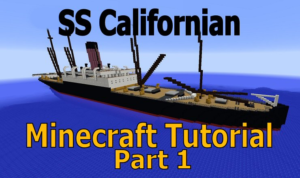
5 videos
SS Californian was a British Leyland Line steamship that is best known for its inaction during the sinking of the RMS Titanic on 15 April 1912, despite being the closest ship in the area. The United States Senate inquiry and British Wreck Commissioner's inquiry into the sinking both concluded that the Californian could have saved many or all of the lives that were lost, had a prompt response been mounted to the Titanic's distress rockets. The U.S. Senate inquiry was particularly critical of the vessel's Captain, Stanley Lord, calling his inaction during the disaster "reprehensible".
Despite this criticism, no formal charges were ever brought against Lord and his crew for their actions. Lord disputed the findings and would spend the rest of his life trying to clear his name. In 1992, the UK Government's Marine Accident Investigation Branch re-examined the case and while condemning the inaction of the Californian, also concluded that due to the limited time available, "the effect of Californian taking proper action would have been no more than to place on her the task actually carried out by Carpathia, that is the rescue of those who escaped... [no] reasonably probable action by Captain Lord could have led to a different outcome of the tragedy."
Californian was later sunk herself, on 9 November 1915, by the German submarine U-35, in the Eastern Mediterranean during World War I.
Despite this criticism, no formal charges were ever brought against Lord and his crew for their actions. Lord disputed the findings and would spend the rest of his life trying to clear his name. In 1992, the UK Government's Marine Accident Investigation Branch re-examined the case and while condemning the inaction of the Californian, also concluded that due to the limited time available, "the effect of Californian taking proper action would have been no more than to place on her the task actually carried out by Carpathia, that is the rescue of those who escaped... [no] reasonably probable action by Captain Lord could have led to a different outcome of the tragedy."
Californian was later sunk herself, on 9 November 1915, by the German submarine U-35, in the Eastern Mediterranean during World War I.

11 videos
SS Canberra was an ocean liner, which later operated on cruises, in the P&O fleet from 1961 to 1997. She was built at the Harland and Wolff shipyard in Belfast, Northern Ireland at a cost of £17,000,000. The ship was named on 17 March 1958, after the federal capital of Australia, Canberra. She was launched on 16 March 1960, sponsored by Dame Pattie Menzies, GBE, wife of the then Prime Minister of Australia, Robert Menzies. She entered service in May 1961, and made her maiden voyage starting in June. She appeared in the 1971 James Bond film Diamonds Are Forever. In the 1982 Falklands War she served as a troop ship. In 1997 the singer and songwriter Gerard Kenny released the single "Farewell Canberra" which was specially composed for the last voyage.
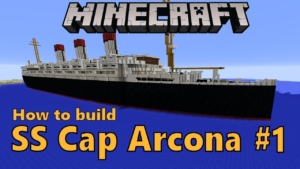
8 videos
Cap Arcona, named after Cape Arkona on the island of Rügen, was a large German ocean liner and the flagship of the Hamburg Südamerikanische Dampfschifffahrts-Gesellschaft ("Hamburg-South America Line"). She took her maiden voyage on 29 October 1927, carrying passengers and cargo between Germany and the east coast of South America, and in her time was the largest and quickest ship on the route.[2]
In 1940 the Kriegsmarine requisitioned her as an accommodation ship. In 1942 she served as the set for the German propaganda feature film Titanic. In 1945 she evacuated almost 26,000 German soldiers and civilians from East Prussia before the advance of the Red Army.
Cap Arcona's final use was as a prison ship. In May 1945 she was heavily laden with prisoners from Nazi concentration camps when the Royal Air Force (the pilots not knowing of the nature of her passengers) bombed her, killing about 5,000 people; with more than 2,000 further casualties in the sinkings of the accompanying vessels of the prison fleet, Deutschland and Thielbek. This was one of the largest single-incident maritime losses of life in the Second World War.
In 1940 the Kriegsmarine requisitioned her as an accommodation ship. In 1942 she served as the set for the German propaganda feature film Titanic. In 1945 she evacuated almost 26,000 German soldiers and civilians from East Prussia before the advance of the Red Army.
Cap Arcona's final use was as a prison ship. In May 1945 she was heavily laden with prisoners from Nazi concentration camps when the Royal Air Force (the pilots not knowing of the nature of her passengers) bombed her, killing about 5,000 people; with more than 2,000 further casualties in the sinkings of the accompanying vessels of the prison fleet, Deutschland and Thielbek. This was one of the largest single-incident maritime losses of life in the Second World War.
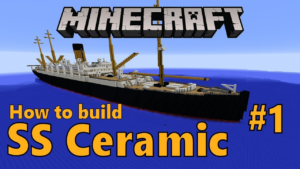
5 videos
SS Ceramic was a British ocean liner built in Belfast for White Star Line in 1912–13 and operated on the Liverpool – Australia route. Ceramic was the largest ship serving the route until P&O introduced RMS Mooltan in 1923. In 1934 Shaw, Savill & Albion Line took over White Star's Australia route and acquired Ceramic. The liner served as a troopship in both World Wars. She was sunk by a German submarine in 1942, leaving only one survivor from the 656 people aboard.
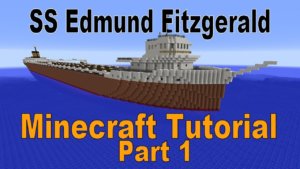
5 videos
SS Edmund Fitzgerald was an American Great Lakes freighter that sank in a Lake Superior storm on November 10, 1975, with the loss of the entire crew of 29. When launched on June 7, 1958, she was the largest ship on North America's Great Lakes, and she remains the largest to have sunk there.
For 17 years, Edmund Fitzgerald carried taconite iron ore from mines near Duluth, Minnesota, to iron works in Detroit, Toledo, and other Great Lakes ports. As a workhorse, she set seasonal haul records six times, often breaking her own previous record. Captain Peter Pulcer was known for piping music day or night over the ship's intercom while passing through the St. Clair and Detroit Rivers (between Lakes Huron and Erie), and entertaining spectators at the Soo Locks (between Lakes Superior and Huron) with a running commentary about the ship.[5] Her size, record-breaking performance, and "DJ captain" endeared Edmund Fitzgerald to boat watchers.
Carrying a full cargo of ore pellets with Captain Ernest M. McSorley in command, she embarked on her ill-fated voyage from Superior, Wisconsin, near Duluth, on the afternoon of November 9, 1975. En route to a steel mill near Detroit, Edmund Fitzgerald joined a second freighter, SS Arthur M. Anderson. By the next day, the two ships were caught in a severe storm on Lake Superior, with near hurricane-force winds and waves up to 35 feet (11 m) high. Shortly after 7:10 p.m., Edmund Fitzgerald suddenly sank in Canadian (Ontario) waters 530 feet (88 fathoms; 160 m) deep, about 17 miles (15 nautical miles; 27 kilometers) from Whitefish Bay near the twin cities of Sault Ste. Marie, Michigan, and Sault Ste. Marie, Ontario—a distance Edmund Fitzgerald could have covered in just over an hour at her top speed. Although Edmund Fitzgerald had reported being in difficulty earlier, no distress signals were sent before she sank; Captain McSorley's last message to Arthur M. Anderson said, "We are holding our own." Her crew of 29 perished, and no bodies were recovered. The exact cause of the sinking remains unknown, though many books, studies, and expeditions have examined it. Edmund Fitzgerald may have been swamped, suffered structural failure or topside damage, been shoaled, or suffered from a combination of these.
For 17 years, Edmund Fitzgerald carried taconite iron ore from mines near Duluth, Minnesota, to iron works in Detroit, Toledo, and other Great Lakes ports. As a workhorse, she set seasonal haul records six times, often breaking her own previous record. Captain Peter Pulcer was known for piping music day or night over the ship's intercom while passing through the St. Clair and Detroit Rivers (between Lakes Huron and Erie), and entertaining spectators at the Soo Locks (between Lakes Superior and Huron) with a running commentary about the ship.[5] Her size, record-breaking performance, and "DJ captain" endeared Edmund Fitzgerald to boat watchers.
Carrying a full cargo of ore pellets with Captain Ernest M. McSorley in command, she embarked on her ill-fated voyage from Superior, Wisconsin, near Duluth, on the afternoon of November 9, 1975. En route to a steel mill near Detroit, Edmund Fitzgerald joined a second freighter, SS Arthur M. Anderson. By the next day, the two ships were caught in a severe storm on Lake Superior, with near hurricane-force winds and waves up to 35 feet (11 m) high. Shortly after 7:10 p.m., Edmund Fitzgerald suddenly sank in Canadian (Ontario) waters 530 feet (88 fathoms; 160 m) deep, about 17 miles (15 nautical miles; 27 kilometers) from Whitefish Bay near the twin cities of Sault Ste. Marie, Michigan, and Sault Ste. Marie, Ontario—a distance Edmund Fitzgerald could have covered in just over an hour at her top speed. Although Edmund Fitzgerald had reported being in difficulty earlier, no distress signals were sent before she sank; Captain McSorley's last message to Arthur M. Anderson said, "We are holding our own." Her crew of 29 perished, and no bodies were recovered. The exact cause of the sinking remains unknown, though many books, studies, and expeditions have examined it. Edmund Fitzgerald may have been swamped, suffered structural failure or topside damage, been shoaled, or suffered from a combination of these.

6 videos
SS Great Eastern was an iron sailing steamship designed by Isambard Kingdom Brunel, and built by J. Scott Russell & Co. at Millwall Iron Works on the River Thames, London. She was by far the largest ship ever built at the time of her 1858 launch, and had the capacity to carry 4,000 passengers from England to Australia without refuelling. Her length of 692 feet (211 m) was only surpassed in 1899 by the 705-foot (215 m) 17,274-gross-ton RMS Oceanic, her gross tonnage of 18,915 was only surpassed in 1901 by the 701-foot (214 m) 21,035-gross-ton RMS Celtic, and her 4,000-passenger capacity was surpassed in 1913 by the 4,935-passenger SS Imperator. The ship's five funnels were rare. These were later reduced to four.
Brunel knew her affectionately as the "Great Babe". He died in 1859 shortly after her ill-fated maiden voyage, during which she was damaged by an explosion. After repairs, she plied for several years as a passenger liner between Britain and North America before being converted to a cable-laying ship and laying the first lasting transatlantic telegraph cable in 1866. Finishing her life as a floating music hall and advertising hoarding (for the department store Lewis's) in Liverpool, she was broken up on Merseyside in 1889.
Brunel knew her affectionately as the "Great Babe". He died in 1859 shortly after her ill-fated maiden voyage, during which she was damaged by an explosion. After repairs, she plied for several years as a passenger liner between Britain and North America before being converted to a cable-laying ship and laying the first lasting transatlantic telegraph cable in 1866. Finishing her life as a floating music hall and advertising hoarding (for the department store Lewis's) in Liverpool, she was broken up on Merseyside in 1889.
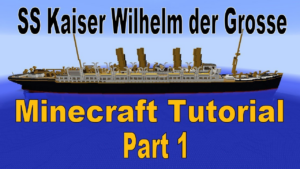
0 videos
Kaiser Wilhelm der Grosse (Ger. orth. Kaiser Wilhelm der Große) was a German transatlantic ocean liner named after Wilhelm I, German Emperor, the first monarch of the (second) German Empire.
The liner was constructed in Stettin (now Szczecin, Poland) for the North German Lloyd (NDL), and entered service in 1897. It was the first liner to have four funnels and is considered to be the first "superliner."[2] The first of four sister ships built between 1903 and 1907 by NDL (the others being SS Kronprinz Wilhelm, SS Kaiser Wilhelm II and SS Kronprinzessin Cecilie, she marked the beginning of a change in the way maritime supremacy was demonstrated in Europe at the beginning of the 20th century.
The ship began a new era in ocean travel and the novelty of having four funnels was quickly associated with size, strength, speed and above all luxury. Quickly established on the Atlantic, she gained the Blue Riband for Germany, a notable prize for the fastest trip from Europe to America which had been previously dominated by the British.
In 1900, she was involved in a fire in the port of New York which resulted in several deaths. She was also the victim of a naval ram in the French port of Cherbourg in 1906. With the advent of her sister ships, she was modified to an all-third-class ship to take advantage of the lucrative immigrant market travelling to the United States.
Converted into an auxiliary cruiser at the outbreak of World War I, she was given orders to capture and destroy enemy ships. She destroyed several before being defeated in the Battle of Río de Oro by the British cruiser HMS Highflyer and scuttled by her crew, just three weeks after the outbreak of war. Her wreck was discovered in 1952 and dismantled..
The liner was constructed in Stettin (now Szczecin, Poland) for the North German Lloyd (NDL), and entered service in 1897. It was the first liner to have four funnels and is considered to be the first "superliner."[2] The first of four sister ships built between 1903 and 1907 by NDL (the others being SS Kronprinz Wilhelm, SS Kaiser Wilhelm II and SS Kronprinzessin Cecilie, she marked the beginning of a change in the way maritime supremacy was demonstrated in Europe at the beginning of the 20th century.
The ship began a new era in ocean travel and the novelty of having four funnels was quickly associated with size, strength, speed and above all luxury. Quickly established on the Atlantic, she gained the Blue Riband for Germany, a notable prize for the fastest trip from Europe to America which had been previously dominated by the British.
In 1900, she was involved in a fire in the port of New York which resulted in several deaths. She was also the victim of a naval ram in the French port of Cherbourg in 1906. With the advent of her sister ships, she was modified to an all-third-class ship to take advantage of the lucrative immigrant market travelling to the United States.
Converted into an auxiliary cruiser at the outbreak of World War I, she was given orders to capture and destroy enemy ships. She destroyed several before being defeated in the Battle of Río de Oro by the British cruiser HMS Highflyer and scuttled by her crew, just three weeks after the outbreak of war. Her wreck was discovered in 1952 and dismantled..
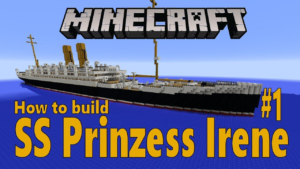
5 videos
USS Pocahontas (SP-3044) was a transport ship for the United States Navy during World War I. She was originally SS Prinzess Irene, a Barbarossa-class ocean liner built in 1899 by AG Vulcan Stettin of Stettin, Germany, for the North German Lloyd line.
At the beginning of World War I the ship was in New York and was interned by the United States. She was seized when that country entered the conflict in 1917 and converted to a troop transport. As USS Pocohantas, she carried 24,573 servicemen to Europe, and after the war returned 23,296 servicemen to the United States.
Decommissioned by the U.S. Navy, the United States Shipping Board sold her back to the North German Lloyd line, where she saw mercantile service until being scrapped in 1932.
At the beginning of World War I the ship was in New York and was interned by the United States. She was seized when that country entered the conflict in 1917 and converted to a troop transport. As USS Pocohantas, she carried 24,573 servicemen to Europe, and after the war returned 23,296 servicemen to the United States.
Decommissioned by the U.S. Navy, the United States Shipping Board sold her back to the North German Lloyd line, where she saw mercantile service until being scrapped in 1932.
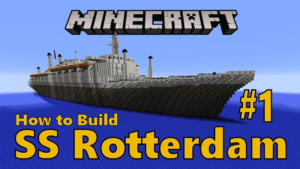
7 videos
The fifth SS Rotterdam, also known as "The Grande Dame", is a former ocean liner and cruise ship, and has been a hotel ship in Rotterdam, the Netherlands, since 2010. She was launched by Queen Juliana of the Netherlands in a gala ceremony on 13 September 1958, and was completed the following summer. The Rotterdam was the last great Dutch "ship of state", employing the finest artisans from the Netherlands in her construction and fitting out process. Her career spanned forty-one years. She sailed from 1959 until her final retirement in September 2000.
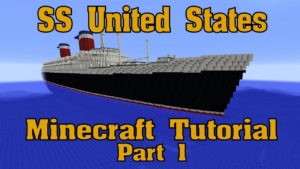
0 videos
SS United States is a retired ocean liner built in 1950–51 for the United States Lines at a cost of US$79.4 million. The ship is the largest ocean liner constructed entirely in the United States and the fastest ocean liner to cross the Atlantic in either direction, retaining the Blue Riband for the highest average speed since her maiden voyage in 1952. She was designed by American naval architect William Francis Gibbs and could be converted into a troopship if required by the Navy in time of war. The United States maintained an uninterrupted schedule of transatlantic passenger service until 1969 and was never used as a troopship.
The ship has been sold several times since the 1970s, with each new owner trying unsuccessfully to make the liner profitable. Eventually, the ship's fittings were sold at auction, and hazardous wastes, including asbestos panels throughout the ship, were removed, leaving her almost completely stripped by 1994. Two years later, she was towed to Pier 82 on the Delaware River, in Philadelphia, where she remains today.
Since 2009, a preservation group called the SS United States Conservancy has been raising funds to save the ship. The group purchased her in 2011 and has drawn up several unrealized plans to restore the ship, one of which included turning the ship into a multi-purpose waterfront complex. In 2015, as its funds dwindled, the group began accepting bids to scrap the ship; however, sufficient donations came in via extended fundraising. Large donations have kept the ship berthed at its Philadelphia dock while the group continues to further investigate restoration plans.
The ship has been sold several times since the 1970s, with each new owner trying unsuccessfully to make the liner profitable. Eventually, the ship's fittings were sold at auction, and hazardous wastes, including asbestos panels throughout the ship, were removed, leaving her almost completely stripped by 1994. Two years later, she was towed to Pier 82 on the Delaware River, in Philadelphia, where she remains today.
Since 2009, a preservation group called the SS United States Conservancy has been raising funds to save the ship. The group purchased her in 2011 and has drawn up several unrealized plans to restore the ship, one of which included turning the ship into a multi-purpose waterfront complex. In 2015, as its funds dwindled, the group began accepting bids to scrap the ship; however, sufficient donations came in via extended fundraising. Large donations have kept the ship berthed at its Philadelphia dock while the group continues to further investigate restoration plans.
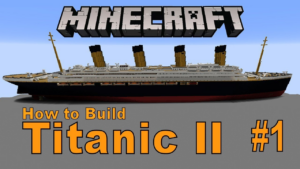
5 videos
Titanic II is a planned passenger ocean liner intended to be a functional modern-day replica of the Olympic-class RMS Titanic. The new ship is planned to have a gross tonnage (GT) of 56,000, while the original ship measured about 46,000 gross register tons (GRT). The project was announced by Australian billionaire Clive Palmer in April 2012 as the flagship of the proposed cruise company Blue Star Line Pty. Ltd. of Brisbane, Australia. The intended launch date was originally set in 2016, delayed to 2018,[5] then 2022. The development of the project was resumed in November 2018 after a hiatus which began in 2015, caused by a financial dispute that affected the $500 million project.

